

C++ Java (Programming) Go (golang) Structured programming. It emerged in the late 1950s with the appearance of the ALGOL 58 and ALGOL 60 programming languages,[1] with the latter including support for block structures.
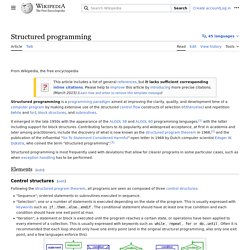
Contributing factors to its popularity and widespread acceptance, at first in academia and later among practitioners, include the discovery of what is now known as the structured program theorem in 1966,[2] and the publication of the influential "Go To Statement Considered Harmful" open letter in 1968 by Dutch computer scientist Edsger W. Dijkstra, who coined the term "structured programming". Structured programming is most frequently used with deviations that allow for clearer programs in some particular cases, such as when exception handling has to be performed. Elements[edit] Control structures[edit] Following the structured program theorem, all programs are seen as composed of control structures:
C Programming Language (Linux) Pascal (Programming Language) Fortran. Fortran (previously FORTRAN, derived from Formula Translating System) is a general-purpose, imperative programming language that is especially suited to numeric computation and scientific computing.
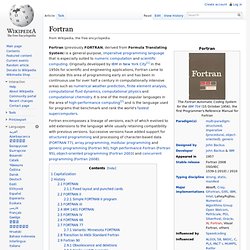
Originally developed by IBM in New York City[1] in the 1950s for scientific and engineering applications, Fortran came to dominate this area of programming early on and has been in continuous use for over half a century in computationally intensive areas such as numerical weather prediction, finite element analysis, computational fluid dynamics, computational physics and computational chemistry. It is one of the most popular languages in the area of high-performance computing[2] and is the language used for programs that benchmark and rank the world's fastest supercomputers.
Fortran encompasses a lineage of versions, each of which evolved to add extensions to the language while usually retaining compatibility with previous versions.
Fourth (Programing Language, Stack Based, Imparative) Imperative programming. The term is often used in contrast to declarative programming, which focuses on what the program should accomplish without specifying how the program should achieve the result.

Imperative and procedural programming[edit] Procedural programming could be considered a step toward declarative programming. A programmer can often tell, simply by looking at the names, arguments, and return types of procedures (and related comments), what a particular procedure is supposed to do, without necessarily looking at the details of how it achieves its result. At the same time, a complete program is still imperative since it fixes the statements to be executed and their order of execution to a large extent.
Imperative (language list - wikipedia) Ada (programming language) Ada was originally designed by a team led by Jean Ichbiah of CII Honeywell Bull under contract to the United States Department of Defense (DoD) from 1977 to 1983 to supersede the hundreds of programming languages then used by the DoD.

Ada was named after Ada Lovelace (1815–1852), who is credited as being the first computer programmer.[5] Ada was originally targeted at embedded and real-time systems. The Ada 95 revision, designed by S. Oberon (programming language) Oberon is still maintained by the original author and the latest revision is from 16 June 2014.

The simplicity resulted in a language which is easy to learn, simple to implement, and also very efficient. Oberon compilers are known to be compact and to compile blazingly fast while providing adequate code quality compared to commercial compilers.[2] The following features characterise the Oberon language: Modula-2. The module as a compilation unit for separate compilationThe coroutine as the basic building block for concurrent processesTypes and procedures that allow access to machine-specific data.
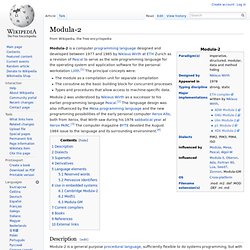
Description[edit] Here is an example of the source code for the "Hello world" program: MODULE Hello; FROM STextIO IMPORT WriteString; BEGIN WriteString("Hello World! "); END Hello. The Modula-2 module may be used to encapsulate a set of related subprograms and data structures, and restrict their visibility from other portions of the program. The language has strict scope control. Suppose module M1 exports objects a, b, c, and P by enumerating its identifiers in an explicit export list DEFINITION MODULE M1; EXPORT QUALIFIED a, b, c, P; ... COBOL. COBOL (/ˈkoʊbɒl/, an acronym for common business-oriented language) is a compiled English-like computer programming language designed for business use.
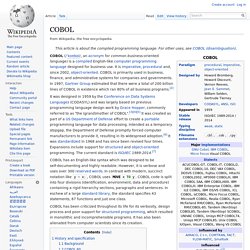
It is imperative, procedural and, since 2002, object-oriented. COBOL is primarily used in business, finance, and administrative systems for companies and governments. In 1997, Gartner Group estimated that there were a total of 200 billion lines of COBOL in existence which ran 80% of all business programs.[2] ALGOL. There were three major specifications: ALGOL 58 – originally proposed to be called IAL (for International Algebraic Language).ALGOL 60 – first implemented as X1 ALGOL 60 in mid-1960 – revised 1963[4][5]ALGOL 68 – revised 1973[6] – introduced new elements including flexible arrays, slices, parallelism, operator identification, and various extensibility features.
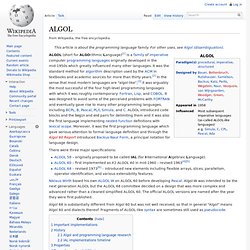
MUMPS. Perhaps the most unusual aspect of the M language is the notion that the database is accessed through variables, rather than queries or retrievals.
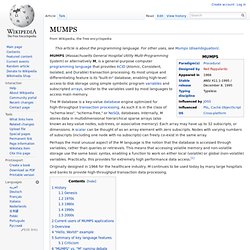
This means that accessing volatile memory and non-volatile storage use the same basic syntax, enabling a function to work on either local (volatile) or global (non-volatile) variables. Practically, this provides for extremely high performance data access.[1] Originally designed in 1966 for the healthcare industry, M continues to be used today by many large hospitals and banks to provide high-throughput transaction data processing. Programming Languages. Programming. Computer Technology.
Technology.